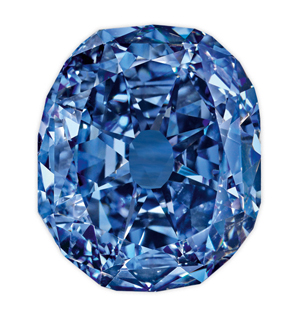
The fancy, deep-blue Wittelsbach-Graff Diamond weighs in at a hefty 31.06 carats. It originally weighed 35.56 carats before it was recut to enhance its clarity and color.
Mined in India, which also yielded the Hope Diamond, the Wittelsbach-Graff Diamond was once part of the dowry of the Spanish Infanta Margarita Téresa, the young princess famously depicted in Diego Velázquez’s masterpiece Las Meninas. The diamond then passed through subsequent marriages to the Wittelsbachs of the House of Bavaria in the 18th century.
A century later, in the aftermath of the first World War, it was confiscated from the displaced royal family, landing on the auction block in London in 1931. Recorded as unsold, the stone seemingly vanished, resurfacing three decades later when Belgian jeweler Joseph Komkommer received a request to re-cut a large stone and recognized it as the historic blue diamond. By the time it came up for auction again in 2008 and was purchased for a record (at auction) $24.3 million by London jeweler Laurence Graff, the gem had sustained significant damage that required repair to return it to its status as a flawless, fancy deep blue diamond. The re-cutting did not alter the gem’s distinctive shape but did merit a new name, the Wittelsbach-Graff Diamond, to signal both its history and its 21st-century renaissance.
The Wittelsbach-Graff Diamond is in very rare company. Based on its distinctive composition—specifically the absence of nitrogen and the presence of boron, which gives the gem its distinctive color—it is classified as a Type IIb diamond. Such stones are believed to make up less than half of one percent of all diamonds found in nature. Type IIb diamonds also share another unusual characteristic: they are semiconductors. Other famous examples of this unique group of gems include the 70.21-carat Idol’s Eye, believed to be in private hands, and the celebrated 45.52-carat Hope Diamond, which is on permanent display at the Smithsonian’s Natural History Museum in Washington, D.C.
Auction Central News gratefully acknowledges use of contents from the article about the Wittelsbach-Graff Diamond originally appearing in the Fall 2010 issue of Rotunda, the magazine for the American Museum of Natural History’s members.
# # #


